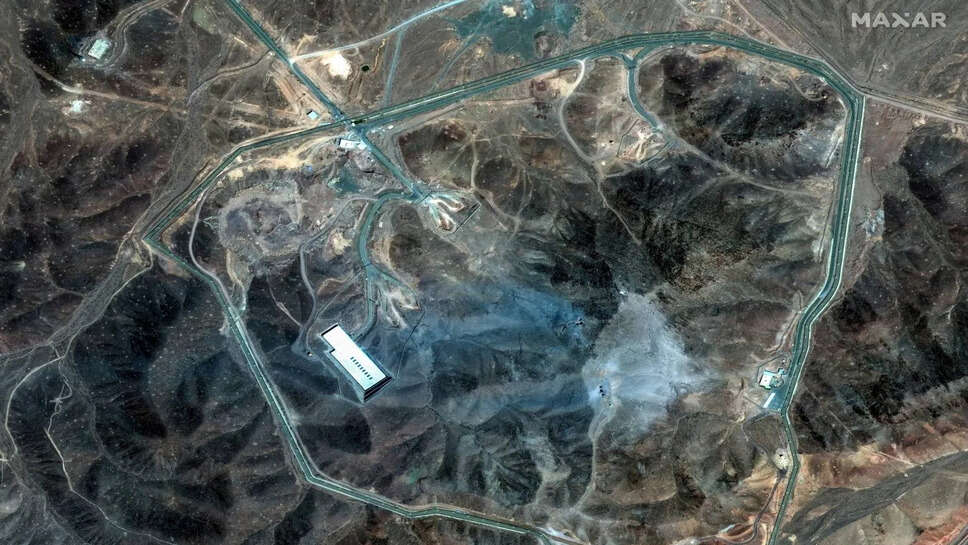Post-Strike Satellite Images Show Iran Working to Reopen Bombed Nuclear Site

Satellite Images Reveal Activity at Iran’s Fordow Nuclear Site After U.S. Strike
Fresh satellite imagery has revealed that Iran has begun ground-level activity at its heavily fortified Fordow nuclear site, days after it was targeted in a U.S. airstrike. The facility, buried deep inside a mountain and long considered one of Iran’s most secure nuclear locations, was hit as part of a precision bombing campaign aimed at halting Iran’s nuclear enrichment program. Despite the strike, images now show bulldozers, excavators, and heavy machinery at work—signaling that Iran may be attempting to repair, restore, or even expand the bombed site.
🛰️ What the Satellite Imagery Shows
The latest satellite photographs indicate:
-
Crater damage across the mountainside where the Fordow facility is partially located underground.
-
Multiple construction vehicles moving soil, filling craters, and clearing access roads.
-
Tunnels or entrances being covered with earth, possibly to conceal the extent of internal damage or to stabilize entryways.
-
Signs of logistical infrastructure being rebuilt—including transport roads and staging areas—suggesting a possible return to operation.
This activity, occurring just days after the high-precision U.S. strike, raises fresh questions about how much damage the operation inflicted—and whether Iran's nuclear capabilities were meaningfully disrupted.
🎯 Why Fordow Was Targeted
The Fordow facility has long been a focal point in nuclear negotiations due to its strategic location and advanced enrichment capabilities. Embedded deep in a mountain near the city of Qom, it was believed to be resilient against conventional airstrikes.
The U.S. strike was designed to:
-
Destroy or damage high-grade centrifuges used to enrich uranium close to weapons-grade levels.
-
Delay Iran’s nuclear breakout timeline, preventing the nation from potentially building a nuclear weapon.
-
Demonstrate military capability and resolve, particularly amid collapsing diplomatic talks and heightened regional tension.
Fordow's hardened construction made it a symbol of defiance—and a prime target.
🧩 Is the Facility Operational Again?
From the outside, it's unclear how deep or lasting the damage was. What is clear is that Iran has quickly mobilized resources to manage the aftermath:
-
Earth-moving equipment is actively filling crater holes and removing rubble.
-
Some entrances and access points appear to be intentionally sealed or rerouted.
-
The quick pace of this activity suggests plans to resume operations, at least in some capacity, possibly using undamaged parts of the complex.
Military analysts caution that although the surface-level destruction is visible, satellite imagery cannot confirm the full impact inside the underground halls—where uranium enrichment actually takes place.
🔬 The Nuclear Program: Damaged or Delayed?
Despite bold claims that Iran’s program was “completely destroyed,” there are reasons to believe this strike may have only temporarily delayed progress.
-
Material Could Have Been Moved: There is growing speculation that Iran relocated key equipment and enriched uranium stockpiles ahead of the strike. Some convoys were reportedly seen leaving the area days before the attack.
-
Centrifuge Halls May Be Intact: The MOP (Massive Ordnance Penetrator) bombs used are designed to penetrate deep underground, but Fordow’s reinforced concrete and mountainous terrain could have shielded parts of the enrichment facility.
-
Rebuilding Is Possible: Iran has significant engineering capabilities. Even if parts of the site were damaged, restoration may only take months, not years.
🛑 IAEA Access and International Oversight
Following the strike, Iran suspended inspections by the International Atomic Energy Agency (IAEA). This has raised international alarm, as the absence of oversight increases the risk of hidden enrichment activity or secret relocation of sensitive materials.
The IAEA has called for immediate access to assess damage and verify the location of nuclear materials. However, with political tensions rising, Iran may delay or deny such access altogether.
🌍 Global and Regional Repercussions
The U.S. strike—and Iran’s swift reaction—have set off a new wave of geopolitical fallout:
-
Iran has vowed retaliation, describing the attack as a violation of its sovereignty and warning of a broader regional response.
-
Neighboring countries are on alert, fearing escalation across borders.
-
Nuclear diplomacy is frozen, with both sides hardening their positions.
-
The attack may also encourage Iran to disperse its program, making future sites harder to detect or target.
There is also growing concern that Iran could withdraw entirely from nuclear non-proliferation frameworks and accelerate its enrichment in hidden sites.
🧭 What Happens Next?
The coming weeks will be critical. Observers are watching for several indicators:
-
Whether Iran resumes enrichment at Fordow or elsewhere.
-
How much time the strike has bought in terms of delaying weaponization capability.
-
Whether diplomacy can resume, or whether this marks a new era of military brinkmanship.
-
If satellite monitoring continues to reveal new sites, suggesting a possible shift to covert operations.
Military planners and intelligence agencies will also assess whether a second round of strikes might be needed—and if Iran has set up decoys or alternate bunkers elsewhere.
The Fordow strike was intended as a high-risk, high-reward move—cripple Iran’s nuclear capacity and force a diplomatic reset. But satellite images showing ongoing reconstruction suggest that Iran is neither retreating nor hesitating. While the operation may have damaged infrastructure and delayed plans, it has not eliminated Iran’s nuclear ambitions.
The real test now lies ahead: whether the world can prevent further escalation, reestablish oversight, and keep Iran’s nuclear ambitions in check—before rebuilding leads to rearming.
